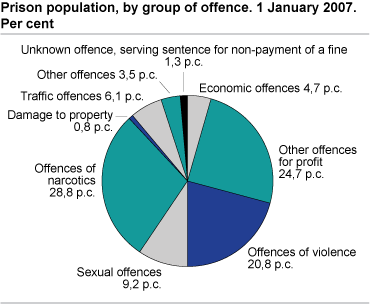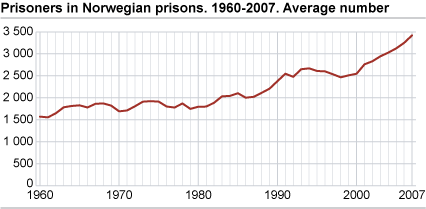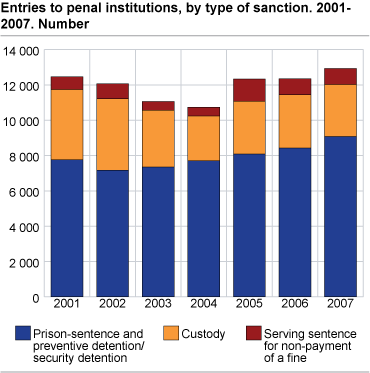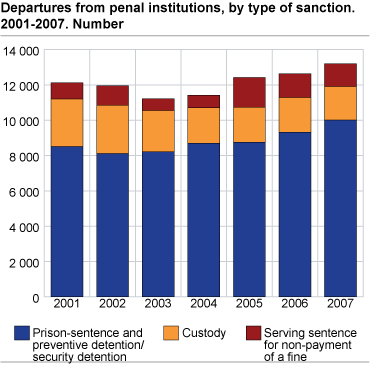Content
Published:
This is an archived release.
More in prison and more time in custody
There were an average of 3 420 prisoners in Norwegian prisons in 2007; an increase of 5 per cent from the previous year and 24 per cent from 2001. The increase from 2006 particularly applies to prisoners remanded in custody, due to the fact that more are spending a long time in custody.
On an average day, 2 594 persons were serving a prison sentence, 78 were in preventive detention/security detention, 84 were serving sentences for non-payment of a fine, and 664 persons were in custody. Compared to the previous year, 3 per cent more were serving prison sentences. With a 16 per cent increase from 2006, the average number of prisoners in custody was similar to the top year 2002. The female portion among all prisoners of 5.4 per cent, was at about the same level as the previous year.
Most for narcotics at the beginning of the year
As per 1 January 2007, the prison population in Norwegian prisons totalled 3 446; an increase of 3 per cent from 2006. The number of prisoners aged 25 and over was 5 per cent higher than the previous year, whilst prisoners younger than 25 years fell by 2 per cent.
Prisoners that had committed crimes made up 92 per cent of all prisoners. At the beginning of the year, the largest portion of prisoners’ principle offence was a narcotic offence (29 per cent), followed by other offences for profit (25 per cent) and violent offences (21 per cent).
The share remanded in custody was lowest among prisoners for traffic offences and economic offences (2 and 7 per cent respectively). At the other extreme are prisoners with a principle offence that goes under the composite category “other offences”, where more than one third were in custody at the beginning of the year (see text table and figure).
| Group of offence | Total 1 | Prison- sentence | Custody | Preventive detention/ Security detention | |||||||||||||||||||||||||||||||||||
|---|---|---|---|---|---|---|---|---|---|---|---|---|---|---|---|---|---|---|---|---|---|---|---|---|---|---|---|---|---|---|---|---|---|---|---|---|---|---|---|
| All types of offences 1 | 3 446 | 2 751 | 575 | 76 | |||||||||||||||||||||||||||||||||||
| Economic offences | 161 | 149 | 12 | - | |||||||||||||||||||||||||||||||||||
| Other offences for profit | 852 | 679 | 168 | 5 | |||||||||||||||||||||||||||||||||||
| Offences of violence | 717 | 552 | 122 | 43 | |||||||||||||||||||||||||||||||||||
| Sexual offences | 318 | 260 | 33 | 25 | |||||||||||||||||||||||||||||||||||
| Offences of narcotics | 993 | 811 | 182 | - | |||||||||||||||||||||||||||||||||||
| Damage to property | 29 | 17 | 9 | 3 | |||||||||||||||||||||||||||||||||||
| Traffic offences | 210 | 206 | 4 | - | |||||||||||||||||||||||||||||||||||
| Other offences | 122 | 77 | 45 | - | |||||||||||||||||||||||||||||||||||
| 1 | Including 44 cases of serving sentence for non-payment of a fine, which can not be distributed by type of sanction and group of offence. |
Number of imprisonments continues to rise
During 2007, 12 500 imprisonments were registered in Norwegian prisons; an increase of 5 per cent from the previous year.
Narcotic offences have increased the most, both in absolute figures and per cent (10 per cent). The largest increase in absolute figures was for provisions under the Penal Code, but the percentual increase was higher in relation to the Act relating to medicinal goods etc. (24 per cent). Second were traffic offences with 7 per cent, where drink-driving accounted for the whole increase.
“Other offences for profit” is the offence group that results in most imprisonments, and accounted for 23 per cent of the total in 2007. This was an increase of 5 per cent from the previous year. There was a considerable decrease (7 per cent) for aggravated larceny, compared with an increase in imprisonments for receiving stolen goods (20 per cent), robbery (28 per cent) and fraud and breach of trust (9 per cent).
The increase in violence was not as high last year (3 per cent), but in the period 2004 to 2007 it was 28 per cent. In absolute figures, the increase was largest for wounding or inflicting bodily harm, which alone came to 37 per cent of the total increase of violent offences. Assaulting a public servant, crimes against personal liberty and assault increased more however (by 40, 31 and 27 per cent respectively).
| Group of offence | 2001 | 2002 | 2003 | 2004 | 2005 | 2006 | 2007 | ||||||||||||||||||||||||||||||||
|---|---|---|---|---|---|---|---|---|---|---|---|---|---|---|---|---|---|---|---|---|---|---|---|---|---|---|---|---|---|---|---|---|---|---|---|---|---|---|---|
| All types of offences | 12 046 | 11 649 | 10 686 | 10 326 | 11 914 | 11 938 | 12 514 | ||||||||||||||||||||||||||||||||
| Economic offences | 538 | 555 | 533 | 533 | 679 | 636 | 672 | ||||||||||||||||||||||||||||||||
| Other offences for profit | 3 061 | 2 905 | 2 560 | 2 278 | 2 756 | 2 707 | 2 839 | ||||||||||||||||||||||||||||||||
| Offences of violence | 1 980 | 1 940 | 1 899 | 1 791 | 2 055 | 2 228 | 2 292 | ||||||||||||||||||||||||||||||||
| Sexual offences | 321 | 280 | 303 | 334 | 325 | 413 | 425 | ||||||||||||||||||||||||||||||||
| Offences of narcotics | 2 000 | 1 897 | 1 677 | 1 634 | 1 615 | 1 761 | 1 941 | ||||||||||||||||||||||||||||||||
| Traffic offences | 2 635 | 2 466 | 2 430 | 2 485 | 2 423 | 2 397 | 2 558 | ||||||||||||||||||||||||||||||||
| Other offences 1 | 719 | 729 | 716 | 659 | 854 | 934 | 916 | ||||||||||||||||||||||||||||||||
| Unknown offence | 93 | 64 | 90 | 133 | 7 | - | 1 | ||||||||||||||||||||||||||||||||
| Unknown offence, serving sentence for not paying a fine | 699 | 813 | 478 | 479 | 1 203 | 862 | 870 | ||||||||||||||||||||||||||||||||
| 1 | Including damage to property, environment offences and work environment offences. |
More imprisonment of adults
A total of 8 700 of all imprisonments in 2007 applied to serving a prison sentence, compared with 8 100 the previous year; an increase of 8 per cent. Thus, imprisonments to serve a prison sentence made up 69 per cent of all imprisonments, compared with 67 per cent in 2006. Prisoners aged 40 years and older had the largest increase, which corresponds to almost half the total increase. There was however also a considerable increase for the age group 25 to 29, with 14 per cent more than the year before.
The imprisonments to custody fell by 2 per cent from 2006. This is due to fewer males being held in custody. These imprisonments accounted for almost a quarter (24 per cent) of the total, which is on a par with the three previous years.
More time in custody
In 2007, there were a total of 12 800 discharges from Norwegians prisons; an increase of 4 per cent from the previous year. Discharges from a prison sentence increased by 8 per cent, whilst discharges from custody on the other hand fell by 4 per cent. Fewer of the discharges happened during the first month (after imprisonment); 57 per cent in 2007 compared with 61 per cent the year before. A greater portion of the discharges happened from one month to one year in custody (42 per cent in 2007, compared with 37 per cent the year before). The increase in prisoners who spent a long time in custody can also be seen in the statistics on transfers from custody to serving a sentence, where the portion of time in custody exceeding three months is increased from 31 to 36 per cent. We have noticed there were fewer imprisonments but an increase in the average number of prisoners held in custody from 2006 to 2007 - due to the increase in the length of detainment in custody.
More sentences for non-payment of a fine and preventive detentions in 2007The absolute figures for the average prison population and new imprisonments for non-payment of a fine in 2007 were higher than in an ordinary year. This could be connected with the reduction of queues for serving a sentence that occurred in 2007. An apparent increase of 46 persons occurred in 2007 from the previous year in relation to the number of prisoners sentenced to preventive detention. This is due to insufficient reporting in the data basis for previous years in relation to those sentenced to preventive detention. |
New in 2007 for the statistics on imprisonmentsCategory of offence: Using the new method to compile the data basis for the statistics on imprisonment, several units without a specific category of offence are now specified. This entailed both a higher number of imprisonments and discharges for crimes (17 and 12 respectively), and more imprisonments and discharges for misdemeanours (39 and 37 respectively). The number is similarly reduced for the unspecified type “Crimes or misdemeanours”.
Group of offence: In 2007, “group of offence” was for the first time used as a standard in the statistics on imprisonment. In line with this standard, all crimes and misdemeanours are classified in ten groups of offences (see NOS Crime Statistics , appendix B). |
Tables
Contact
-
Susanne Fjelldalen
E-mail: susanne.fjelldalen@ssb.no
tel.: (+47) 40 90 26 43
-
Kristin Bergvall
E-mail: kristin.bergvall@ssb.no
tel.: (+47) 92 66 55 13
-
Reid Jone Stene
E-mail: reid.jone.stene@ssb.no
tel.: (+47) 99 02 22 01




